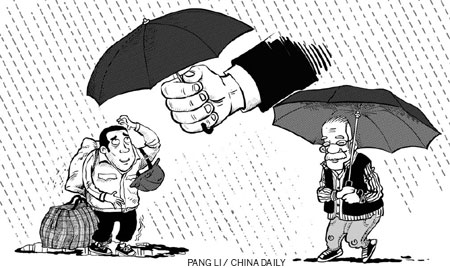
China's economy has developed significantly in the last decades, lifting millions of people out of poverty and improving their health. One of the consequences of the nation's economic progress has been the increase in life expectancy, to 72.5 in 2010. Despite this progress, however, many health issues remain unresolved. While the wealthier portion of the Chinese population has benefited from advanced health technologies, many among the poor do not have adequate access to even the most essential services.
It is estimated that approximately 80 percent of health and medical services are concentrated in cities, which means that timely medical care is not available to more than 100 million people in rural areas. In addition, although almost half of the population lives in rural areas, government expenditures in health tend to heavily favor those living in urban areas.
Although some progress has been made in underdeveloped rural areas, there is still a lack of safe water and sanitation, and widespread under-nutrition, vitamin and mineral deficiencies and indoor air pollution, all of which affect children's health in particular. It is estimated that 80 percent of rural households have no access to a sanitary lavatory and 20 percent of rural households lack safe drinking water.
The government has to address several challenges in healthcare provision, such as the need to improve quality of services, making the healthcare system more equitable, reducing costs by improving efficiency, and improving the health insurance system and making it comprehensive.
It is estimated that China has a highly mobile population of approximately 252 million rural-to-urban migrants, a number that will probably increase in the coming decades. They tend to work in high-risk jobs, such as construction and industries where health and safety are not properly regulated.
These migrant workers have special health needs that have to be adequately addressed, particularly since they usually do not qualify for public medical insurance, which usually depend on locally based household schemes. Rural migrants working in the cities constitute a population whose health status and needs are usually not monitored by either the rural or the urban health systems.
Migrants also tend to suffer from different diseases than the non-migrant urban population.Migrants tend to have more communicable diseases, such as sexually transmitted diseases and tuberculosis. In addition, migration is a source of stress and stress-related diseases such as depression, as a result of isolation and the lack of family support. Stress can exacerbate physical health problems and have a negative effect on people's quality of life.
Doctors and health personnel need to be better prepared to respond to people's needs. According to the Organization for Economic Cooperation and Development, almost half of the nation's doctors have no better qualifications than a high school degree. Many rural doctors have less experience and education than their urban counterparts. The education of rural healthcare workers needs to be upgraded. They should also receive economic incentives so that their salaries are on an equal basis with urban doctors.
There are still large disparities in access to services and the quality of care available to urban and rural populations as well as between the poor and the more affluent. Many among the poor limit their use of medical services for purely financial reasons, since the cost of treating a serious illness can wipe out a family's life savings.
New measures proposed by the State Council, which will increase insurance payments to cover a significant part of medical costs will help lower the impact of high out-of-pocket payments. But, in this regard, it is also important to simplify the diversity of schemes paying for health services.
A great proportion of medical costs are due to unnecessary tests and prescriptions. Chinese hospitals' reliance on profits from the sale of drugs has led to the over-prescribing of unnecessary medication in order to increase profitability and some pharmaceutical companies offer under-the-table inducements for prescribing drugs. The resulting high costs of treatment cause many patients to avoid going to hospitals, even for treatment that might be critical.
By some estimates, by 2035, about 25 percent of China's population will be aged 60 or older. Medical costs can increase dramatically with age while at the same time the share of individuals who contribute to government revenues will decline. There has to be a commitment to increase prevention efforts for this sector of the population to improve their health and limit the costs of healthcare.
Although the government has stated that building a "safe, effective, convenient and affordable" health service will not be easy, these are commendable goals. To achieve them, the government should prioritize the promotion of healthy lifestyles and the prevention of chronic non-communicable diseases. Health education should be given priority among government-funded interventions.
The government has taken actions to improve the health of the population, but although millions of people have benefited, millions are still lagging behind. The great challenge for China is how to strengthen its healthcare system to reduce disparities and improve the quality of health care for the majority of the population.
The author is an international public health consultant.
